Macroeconomic Performance of Australia and USA: An Analysis
VerifiedAdded on 2019/11/29
|13
|3071
|122
Report
AI Summary
This report provides a comprehensive analysis of the macroeconomic performance of Australia and the United States, examining their economic trends, trade relationships, and the impact of GDP changes. The study delves into the economies of both nations, highlighting factors such as fiscal and monetary policies, expansions, recessions, and the influence of the US economy on Australia's. The research addresses key questions regarding economic trends, expansions, recessions, and trade relations between the two countries, supported by findings, tables, and graphs. It explores the U.S.-Australia Free Trade Agreement and its effects on trade, employment, and investment, concluding that changes in the U.S. GDP significantly impact the Australian economy due to Australia's relatively smaller economic size and strong trade ties. The report also discusses historical economic events and policies that have shaped both nations' economic landscapes.
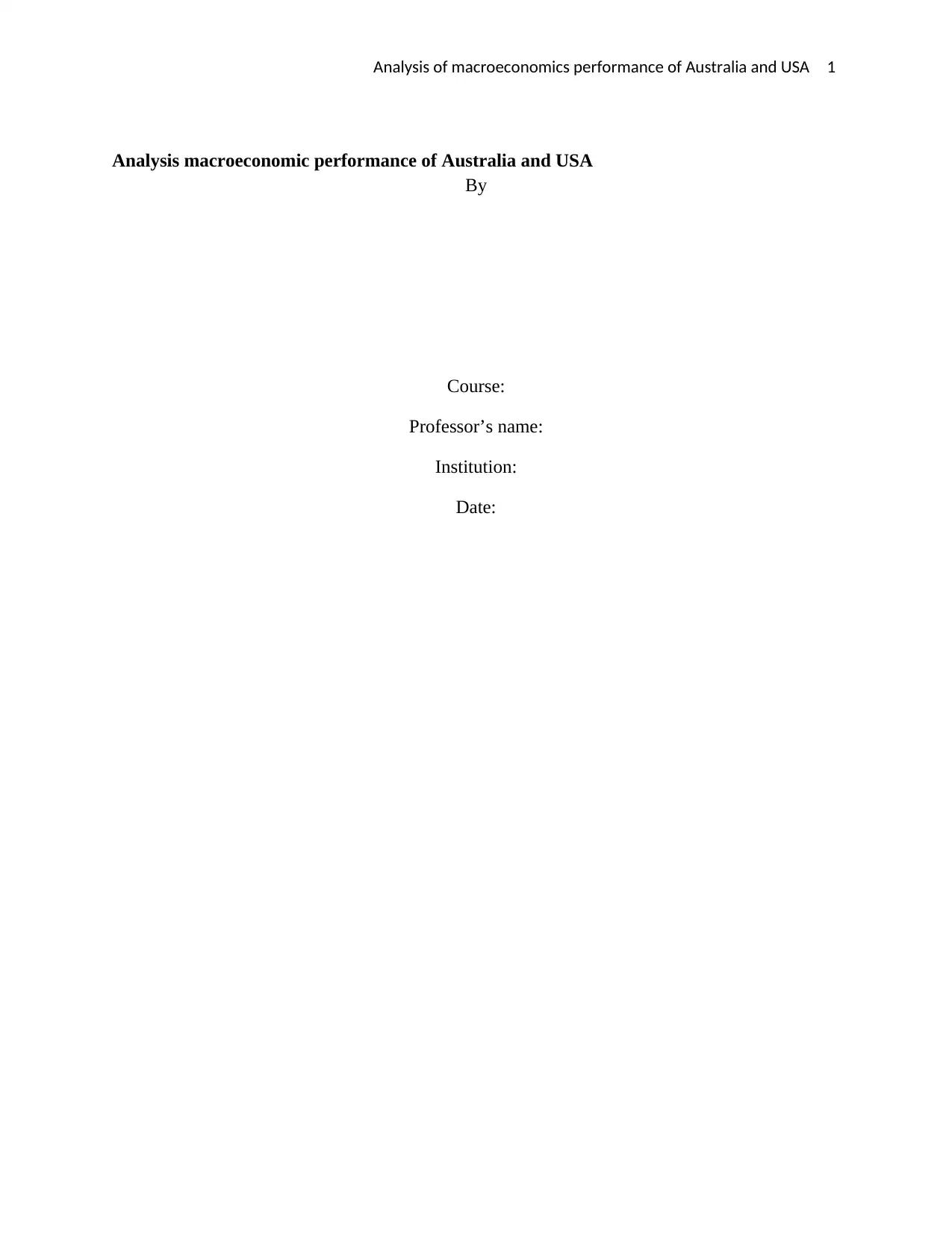
Analysis of macroeconomics performance of Australia and USA 1
Analysis macroeconomic performance of Australia and USA
By
Course:
Professor’s name:
Institution:
Date:
Analysis macroeconomic performance of Australia and USA
By
Course:
Professor’s name:
Institution:
Date:
Paraphrase This Document
Need a fresh take? Get an instant paraphrase of this document with our AI Paraphraser
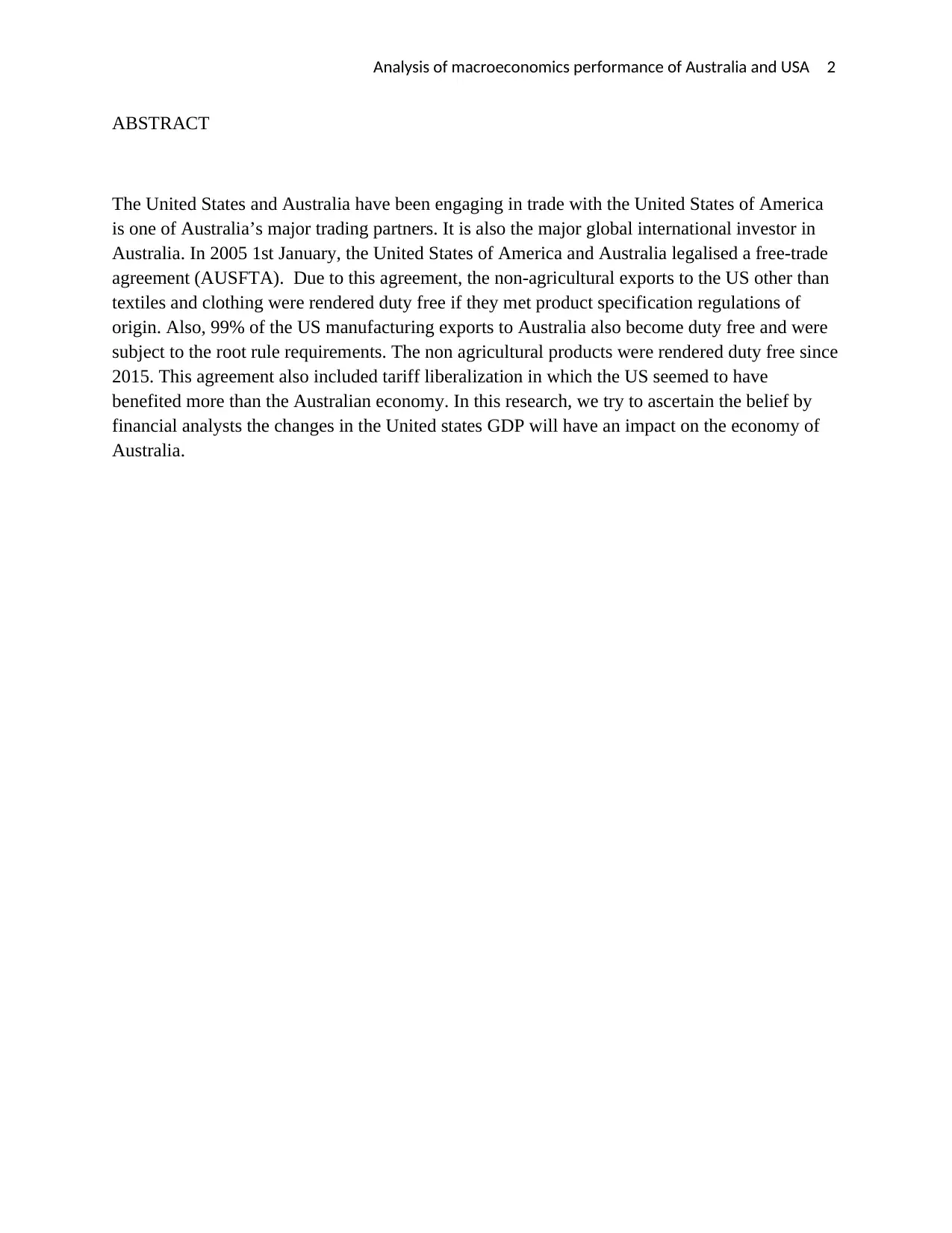
Analysis of macroeconomics performance of Australia and USA 2
ABSTRACT
The United States and Australia have been engaging in trade with the United States of America
is one of Australia’s major trading partners. It is also the major global international investor in
Australia. In 2005 1st January, the United States of America and Australia legalised a free-trade
agreement (AUSFTA). Due to this agreement, the non-agricultural exports to the US other than
textiles and clothing were rendered duty free if they met product specification regulations of
origin. Also, 99% of the US manufacturing exports to Australia also become duty free and were
subject to the root rule requirements. The non agricultural products were rendered duty free since
2015. This agreement also included tariff liberalization in which the US seemed to have
benefited more than the Australian economy. In this research, we try to ascertain the belief by
financial analysts the changes in the United states GDP will have an impact on the economy of
Australia.
ABSTRACT
The United States and Australia have been engaging in trade with the United States of America
is one of Australia’s major trading partners. It is also the major global international investor in
Australia. In 2005 1st January, the United States of America and Australia legalised a free-trade
agreement (AUSFTA). Due to this agreement, the non-agricultural exports to the US other than
textiles and clothing were rendered duty free if they met product specification regulations of
origin. Also, 99% of the US manufacturing exports to Australia also become duty free and were
subject to the root rule requirements. The non agricultural products were rendered duty free since
2015. This agreement also included tariff liberalization in which the US seemed to have
benefited more than the Australian economy. In this research, we try to ascertain the belief by
financial analysts the changes in the United states GDP will have an impact on the economy of
Australia.
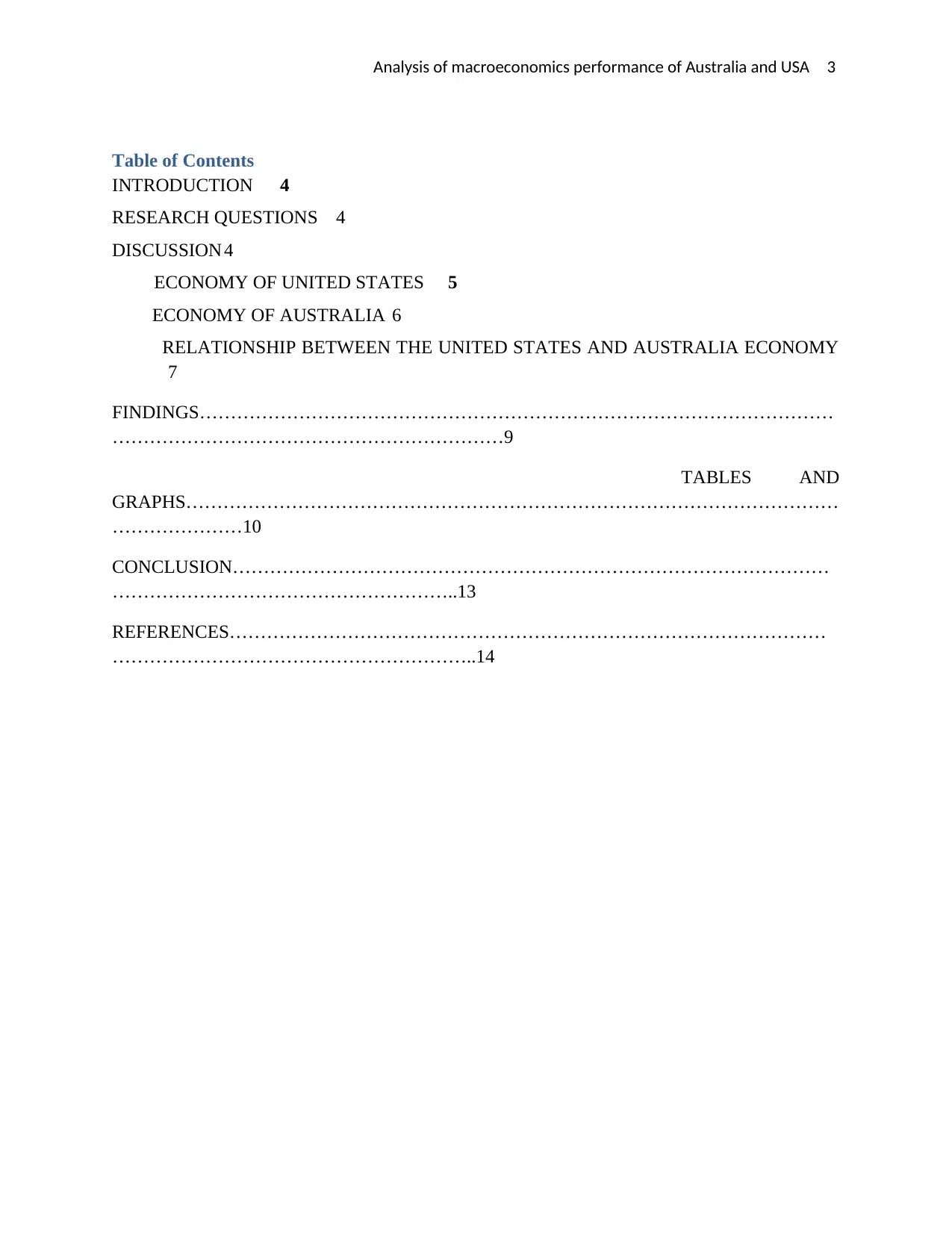
Analysis of macroeconomics performance of Australia and USA 3
Table of Contents
INTRODUCTION 4
RESEARCH QUESTIONS 4
DISCUSSION 4
ECONOMY OF UNITED STATES 5
ECONOMY OF AUSTRALIA 6
RELATIONSHIP BETWEEN THE UNITED STATES AND AUSTRALIA ECONOMY
7
FINDINGS…………………………………………………………………………………………
………………………………………………………9
TABLES AND
GRAPHS……………………………………………………………………………………………
…………………10
CONCLUSION……………………………………………………………………………………
………………………………………………..13
REFERENCES……………………………………………………………………………………
…………………………………………………..14
Table of Contents
INTRODUCTION 4
RESEARCH QUESTIONS 4
DISCUSSION 4
ECONOMY OF UNITED STATES 5
ECONOMY OF AUSTRALIA 6
RELATIONSHIP BETWEEN THE UNITED STATES AND AUSTRALIA ECONOMY
7
FINDINGS…………………………………………………………………………………………
………………………………………………………9
TABLES AND
GRAPHS……………………………………………………………………………………………
…………………10
CONCLUSION……………………………………………………………………………………
………………………………………………..13
REFERENCES……………………………………………………………………………………
…………………………………………………..14
⊘ This is a preview!⊘
Do you want full access?
Subscribe today to unlock all pages.

Trusted by 1+ million students worldwide
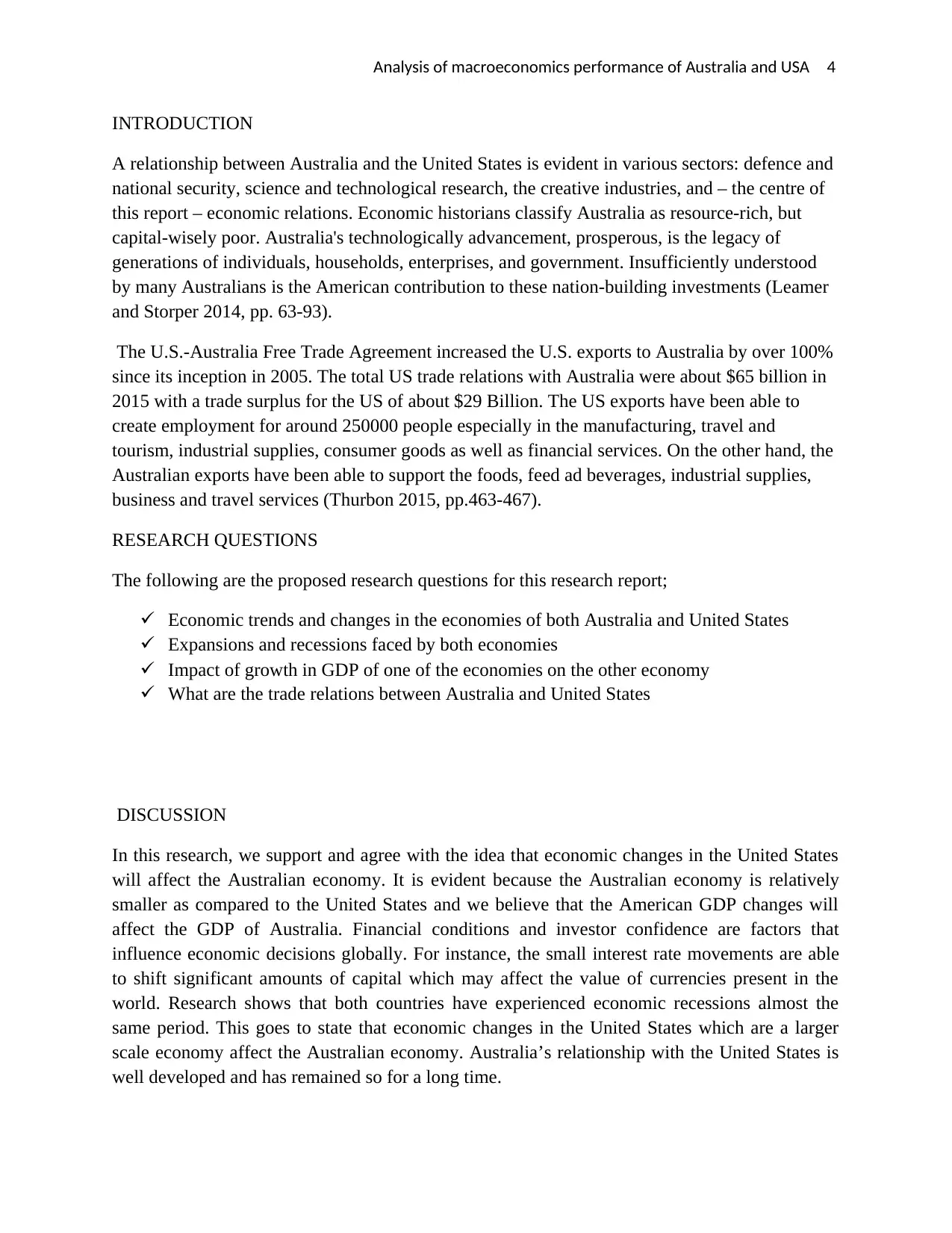
Analysis of macroeconomics performance of Australia and USA 4
INTRODUCTION
A relationship between Australia and the United States is evident in various sectors: defence and
national security, science and technological research, the creative industries, and – the centre of
this report – economic relations. Economic historians classify Australia as resource-rich, but
capital-wisely poor. Australia's technologically advancement, prosperous, is the legacy of
generations of individuals, households, enterprises, and government. Insufficiently understood
by many Australians is the American contribution to these nation-building investments (Leamer
and Storper 2014, pp. 63-93).
The U.S.-Australia Free Trade Agreement increased the U.S. exports to Australia by over 100%
since its inception in 2005. The total US trade relations with Australia were about $65 billion in
2015 with a trade surplus for the US of about $29 Billion. The US exports have been able to
create employment for around 250000 people especially in the manufacturing, travel and
tourism, industrial supplies, consumer goods as well as financial services. On the other hand, the
Australian exports have been able to support the foods, feed ad beverages, industrial supplies,
business and travel services (Thurbon 2015, pp.463-467).
RESEARCH QUESTIONS
The following are the proposed research questions for this research report;
Economic trends and changes in the economies of both Australia and United States
Expansions and recessions faced by both economies
Impact of growth in GDP of one of the economies on the other economy
What are the trade relations between Australia and United States
DISCUSSION
In this research, we support and agree with the idea that economic changes in the United States
will affect the Australian economy. It is evident because the Australian economy is relatively
smaller as compared to the United States and we believe that the American GDP changes will
affect the GDP of Australia. Financial conditions and investor confidence are factors that
influence economic decisions globally. For instance, the small interest rate movements are able
to shift significant amounts of capital which may affect the value of currencies present in the
world. Research shows that both countries have experienced economic recessions almost the
same period. This goes to state that economic changes in the United States which are a larger
scale economy affect the Australian economy. Australia’s relationship with the United States is
well developed and has remained so for a long time.
INTRODUCTION
A relationship between Australia and the United States is evident in various sectors: defence and
national security, science and technological research, the creative industries, and – the centre of
this report – economic relations. Economic historians classify Australia as resource-rich, but
capital-wisely poor. Australia's technologically advancement, prosperous, is the legacy of
generations of individuals, households, enterprises, and government. Insufficiently understood
by many Australians is the American contribution to these nation-building investments (Leamer
and Storper 2014, pp. 63-93).
The U.S.-Australia Free Trade Agreement increased the U.S. exports to Australia by over 100%
since its inception in 2005. The total US trade relations with Australia were about $65 billion in
2015 with a trade surplus for the US of about $29 Billion. The US exports have been able to
create employment for around 250000 people especially in the manufacturing, travel and
tourism, industrial supplies, consumer goods as well as financial services. On the other hand, the
Australian exports have been able to support the foods, feed ad beverages, industrial supplies,
business and travel services (Thurbon 2015, pp.463-467).
RESEARCH QUESTIONS
The following are the proposed research questions for this research report;
Economic trends and changes in the economies of both Australia and United States
Expansions and recessions faced by both economies
Impact of growth in GDP of one of the economies on the other economy
What are the trade relations between Australia and United States
DISCUSSION
In this research, we support and agree with the idea that economic changes in the United States
will affect the Australian economy. It is evident because the Australian economy is relatively
smaller as compared to the United States and we believe that the American GDP changes will
affect the GDP of Australia. Financial conditions and investor confidence are factors that
influence economic decisions globally. For instance, the small interest rate movements are able
to shift significant amounts of capital which may affect the value of currencies present in the
world. Research shows that both countries have experienced economic recessions almost the
same period. This goes to state that economic changes in the United States which are a larger
scale economy affect the Australian economy. Australia’s relationship with the United States is
well developed and has remained so for a long time.
Paraphrase This Document
Need a fresh take? Get an instant paraphrase of this document with our AI Paraphraser
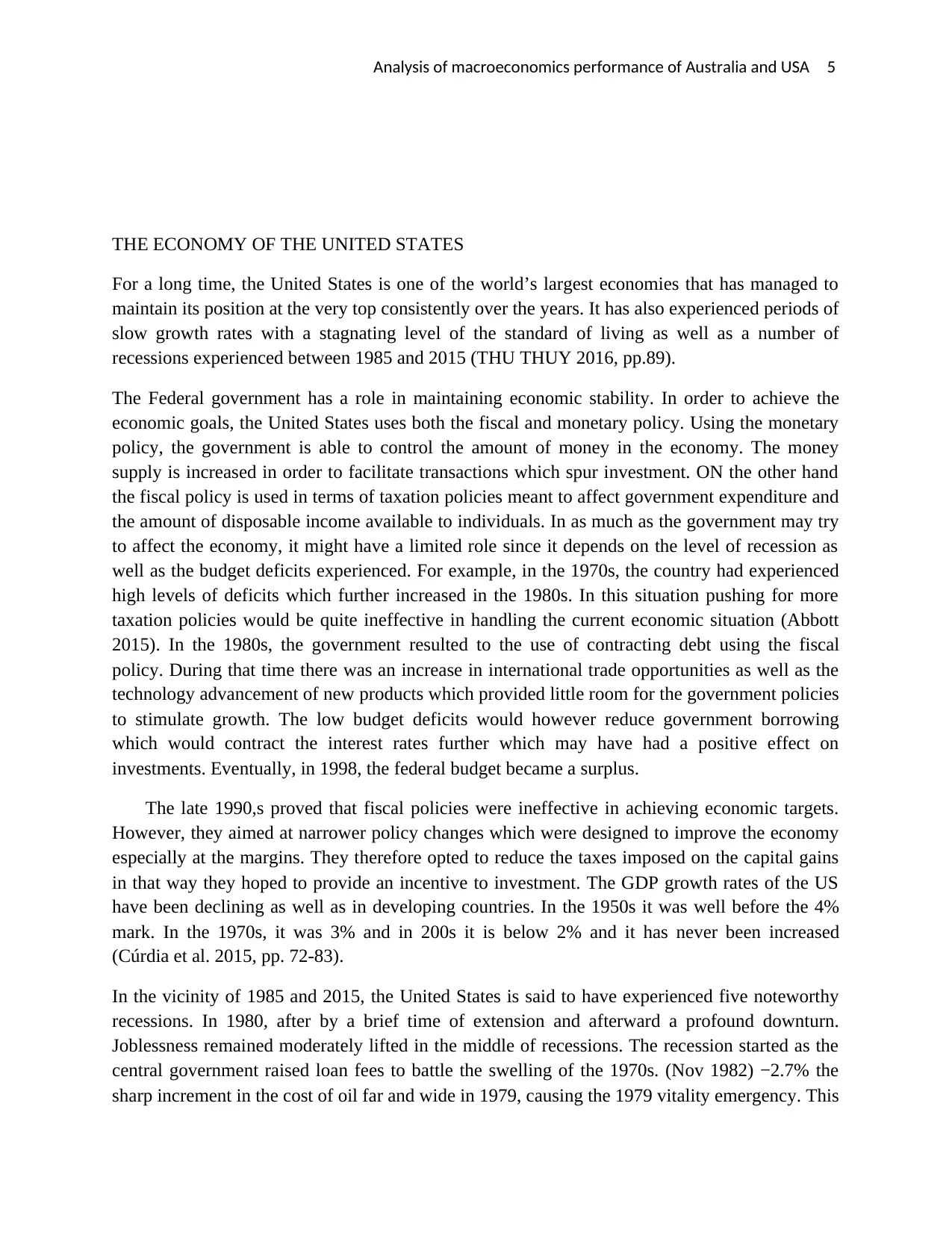
Analysis of macroeconomics performance of Australia and USA 5
THE ECONOMY OF THE UNITED STATES
For a long time, the United States is one of the world’s largest economies that has managed to
maintain its position at the very top consistently over the years. It has also experienced periods of
slow growth rates with a stagnating level of the standard of living as well as a number of
recessions experienced between 1985 and 2015 (THU THUY 2016, pp.89).
The Federal government has a role in maintaining economic stability. In order to achieve the
economic goals, the United States uses both the fiscal and monetary policy. Using the monetary
policy, the government is able to control the amount of money in the economy. The money
supply is increased in order to facilitate transactions which spur investment. ON the other hand
the fiscal policy is used in terms of taxation policies meant to affect government expenditure and
the amount of disposable income available to individuals. In as much as the government may try
to affect the economy, it might have a limited role since it depends on the level of recession as
well as the budget deficits experienced. For example, in the 1970s, the country had experienced
high levels of deficits which further increased in the 1980s. In this situation pushing for more
taxation policies would be quite ineffective in handling the current economic situation (Abbott
2015). In the 1980s, the government resulted to the use of contracting debt using the fiscal
policy. During that time there was an increase in international trade opportunities as well as the
technology advancement of new products which provided little room for the government policies
to stimulate growth. The low budget deficits would however reduce government borrowing
which would contract the interest rates further which may have had a positive effect on
investments. Eventually, in 1998, the federal budget became a surplus.
The late 1990,s proved that fiscal policies were ineffective in achieving economic targets.
However, they aimed at narrower policy changes which were designed to improve the economy
especially at the margins. They therefore opted to reduce the taxes imposed on the capital gains
in that way they hoped to provide an incentive to investment. The GDP growth rates of the US
have been declining as well as in developing countries. In the 1950s it was well before the 4%
mark. In the 1970s, it was 3% and in 200s it is below 2% and it has never been increased
(Cúrdia et al. 2015, pp. 72-83).
In the vicinity of 1985 and 2015, the United States is said to have experienced five noteworthy
recessions. In 1980, after by a brief time of extension and afterward a profound downturn.
Joblessness remained moderately lifted in the middle of recessions. The recession started as the
central government raised loan fees to battle the swelling of the 1970s. (Nov 1982) −2.7% the
sharp increment in the cost of oil far and wide in 1979, causing the 1979 vitality emergency. This
THE ECONOMY OF THE UNITED STATES
For a long time, the United States is one of the world’s largest economies that has managed to
maintain its position at the very top consistently over the years. It has also experienced periods of
slow growth rates with a stagnating level of the standard of living as well as a number of
recessions experienced between 1985 and 2015 (THU THUY 2016, pp.89).
The Federal government has a role in maintaining economic stability. In order to achieve the
economic goals, the United States uses both the fiscal and monetary policy. Using the monetary
policy, the government is able to control the amount of money in the economy. The money
supply is increased in order to facilitate transactions which spur investment. ON the other hand
the fiscal policy is used in terms of taxation policies meant to affect government expenditure and
the amount of disposable income available to individuals. In as much as the government may try
to affect the economy, it might have a limited role since it depends on the level of recession as
well as the budget deficits experienced. For example, in the 1970s, the country had experienced
high levels of deficits which further increased in the 1980s. In this situation pushing for more
taxation policies would be quite ineffective in handling the current economic situation (Abbott
2015). In the 1980s, the government resulted to the use of contracting debt using the fiscal
policy. During that time there was an increase in international trade opportunities as well as the
technology advancement of new products which provided little room for the government policies
to stimulate growth. The low budget deficits would however reduce government borrowing
which would contract the interest rates further which may have had a positive effect on
investments. Eventually, in 1998, the federal budget became a surplus.
The late 1990,s proved that fiscal policies were ineffective in achieving economic targets.
However, they aimed at narrower policy changes which were designed to improve the economy
especially at the margins. They therefore opted to reduce the taxes imposed on the capital gains
in that way they hoped to provide an incentive to investment. The GDP growth rates of the US
have been declining as well as in developing countries. In the 1950s it was well before the 4%
mark. In the 1970s, it was 3% and in 200s it is below 2% and it has never been increased
(Cúrdia et al. 2015, pp. 72-83).
In the vicinity of 1985 and 2015, the United States is said to have experienced five noteworthy
recessions. In 1980, after by a brief time of extension and afterward a profound downturn.
Joblessness remained moderately lifted in the middle of recessions. The recession started as the
central government raised loan fees to battle the swelling of the 1970s. (Nov 1982) −2.7% the
sharp increment in the cost of oil far and wide in 1979, causing the 1979 vitality emergency. This
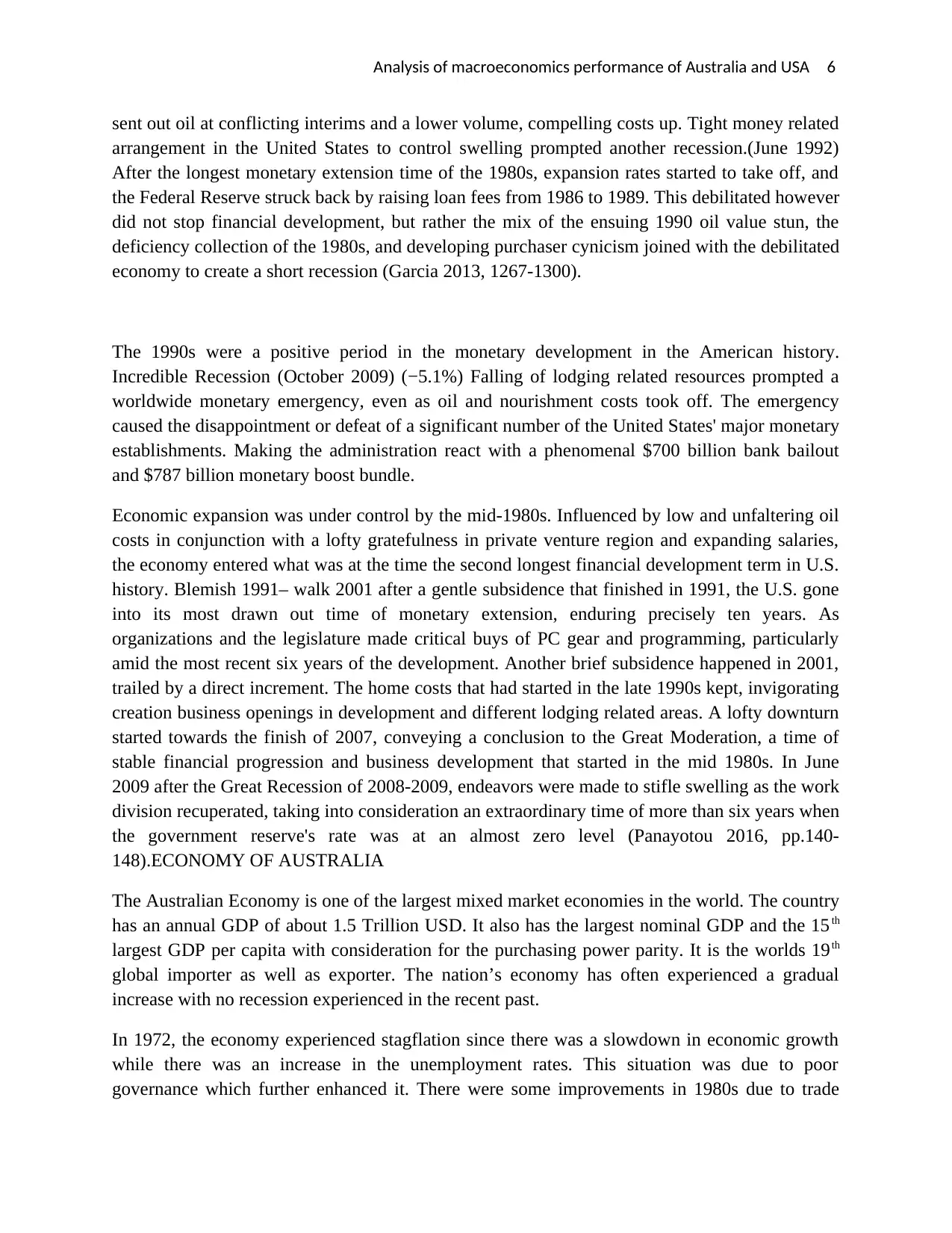
Analysis of macroeconomics performance of Australia and USA 6
sent out oil at conflicting interims and a lower volume, compelling costs up. Tight money related
arrangement in the United States to control swelling prompted another recession.(June 1992)
After the longest monetary extension time of the 1980s, expansion rates started to take off, and
the Federal Reserve struck back by raising loan fees from 1986 to 1989. This debilitated however
did not stop financial development, but rather the mix of the ensuing 1990 oil value stun, the
deficiency collection of the 1980s, and developing purchaser cynicism joined with the debilitated
economy to create a short recession (Garcia 2013, 1267-1300).
The 1990s were a positive period in the monetary development in the American history.
Incredible Recession (October 2009) (−5.1%) Falling of lodging related resources prompted a
worldwide monetary emergency, even as oil and nourishment costs took off. The emergency
caused the disappointment or defeat of a significant number of the United States' major monetary
establishments. Making the administration react with a phenomenal $700 billion bank bailout
and $787 billion monetary boost bundle.
Economic expansion was under control by the mid-1980s. Influenced by low and unfaltering oil
costs in conjunction with a lofty gratefulness in private venture region and expanding salaries,
the economy entered what was at the time the second longest financial development term in U.S.
history. Blemish 1991– walk 2001 after a gentle subsidence that finished in 1991, the U.S. gone
into its most drawn out time of monetary extension, enduring precisely ten years. As
organizations and the legislature made critical buys of PC gear and programming, particularly
amid the most recent six years of the development. Another brief subsidence happened in 2001,
trailed by a direct increment. The home costs that had started in the late 1990s kept, invigorating
creation business openings in development and different lodging related areas. A lofty downturn
started towards the finish of 2007, conveying a conclusion to the Great Moderation, a time of
stable financial progression and business development that started in the mid 1980s. In June
2009 after the Great Recession of 2008-2009, endeavors were made to stifle swelling as the work
division recuperated, taking into consideration an extraordinary time of more than six years when
the government reserve's rate was at an almost zero level (Panayotou 2016, pp.140-
148).ECONOMY OF AUSTRALIA
The Australian Economy is one of the largest mixed market economies in the world. The country
has an annual GDP of about 1.5 Trillion USD. It also has the largest nominal GDP and the 15 th
largest GDP per capita with consideration for the purchasing power parity. It is the worlds 19th
global importer as well as exporter. The nation’s economy has often experienced a gradual
increase with no recession experienced in the recent past.
In 1972, the economy experienced stagflation since there was a slowdown in economic growth
while there was an increase in the unemployment rates. This situation was due to poor
governance which further enhanced it. There were some improvements in 1980s due to trade
sent out oil at conflicting interims and a lower volume, compelling costs up. Tight money related
arrangement in the United States to control swelling prompted another recession.(June 1992)
After the longest monetary extension time of the 1980s, expansion rates started to take off, and
the Federal Reserve struck back by raising loan fees from 1986 to 1989. This debilitated however
did not stop financial development, but rather the mix of the ensuing 1990 oil value stun, the
deficiency collection of the 1980s, and developing purchaser cynicism joined with the debilitated
economy to create a short recession (Garcia 2013, 1267-1300).
The 1990s were a positive period in the monetary development in the American history.
Incredible Recession (October 2009) (−5.1%) Falling of lodging related resources prompted a
worldwide monetary emergency, even as oil and nourishment costs took off. The emergency
caused the disappointment or defeat of a significant number of the United States' major monetary
establishments. Making the administration react with a phenomenal $700 billion bank bailout
and $787 billion monetary boost bundle.
Economic expansion was under control by the mid-1980s. Influenced by low and unfaltering oil
costs in conjunction with a lofty gratefulness in private venture region and expanding salaries,
the economy entered what was at the time the second longest financial development term in U.S.
history. Blemish 1991– walk 2001 after a gentle subsidence that finished in 1991, the U.S. gone
into its most drawn out time of monetary extension, enduring precisely ten years. As
organizations and the legislature made critical buys of PC gear and programming, particularly
amid the most recent six years of the development. Another brief subsidence happened in 2001,
trailed by a direct increment. The home costs that had started in the late 1990s kept, invigorating
creation business openings in development and different lodging related areas. A lofty downturn
started towards the finish of 2007, conveying a conclusion to the Great Moderation, a time of
stable financial progression and business development that started in the mid 1980s. In June
2009 after the Great Recession of 2008-2009, endeavors were made to stifle swelling as the work
division recuperated, taking into consideration an extraordinary time of more than six years when
the government reserve's rate was at an almost zero level (Panayotou 2016, pp.140-
148).ECONOMY OF AUSTRALIA
The Australian Economy is one of the largest mixed market economies in the world. The country
has an annual GDP of about 1.5 Trillion USD. It also has the largest nominal GDP and the 15 th
largest GDP per capita with consideration for the purchasing power parity. It is the worlds 19th
global importer as well as exporter. The nation’s economy has often experienced a gradual
increase with no recession experienced in the recent past.
In 1972, the economy experienced stagflation since there was a slowdown in economic growth
while there was an increase in the unemployment rates. This situation was due to poor
governance which further enhanced it. There were some improvements in 1980s due to trade
⊘ This is a preview!⊘
Do you want full access?
Subscribe today to unlock all pages.

Trusted by 1+ million students worldwide
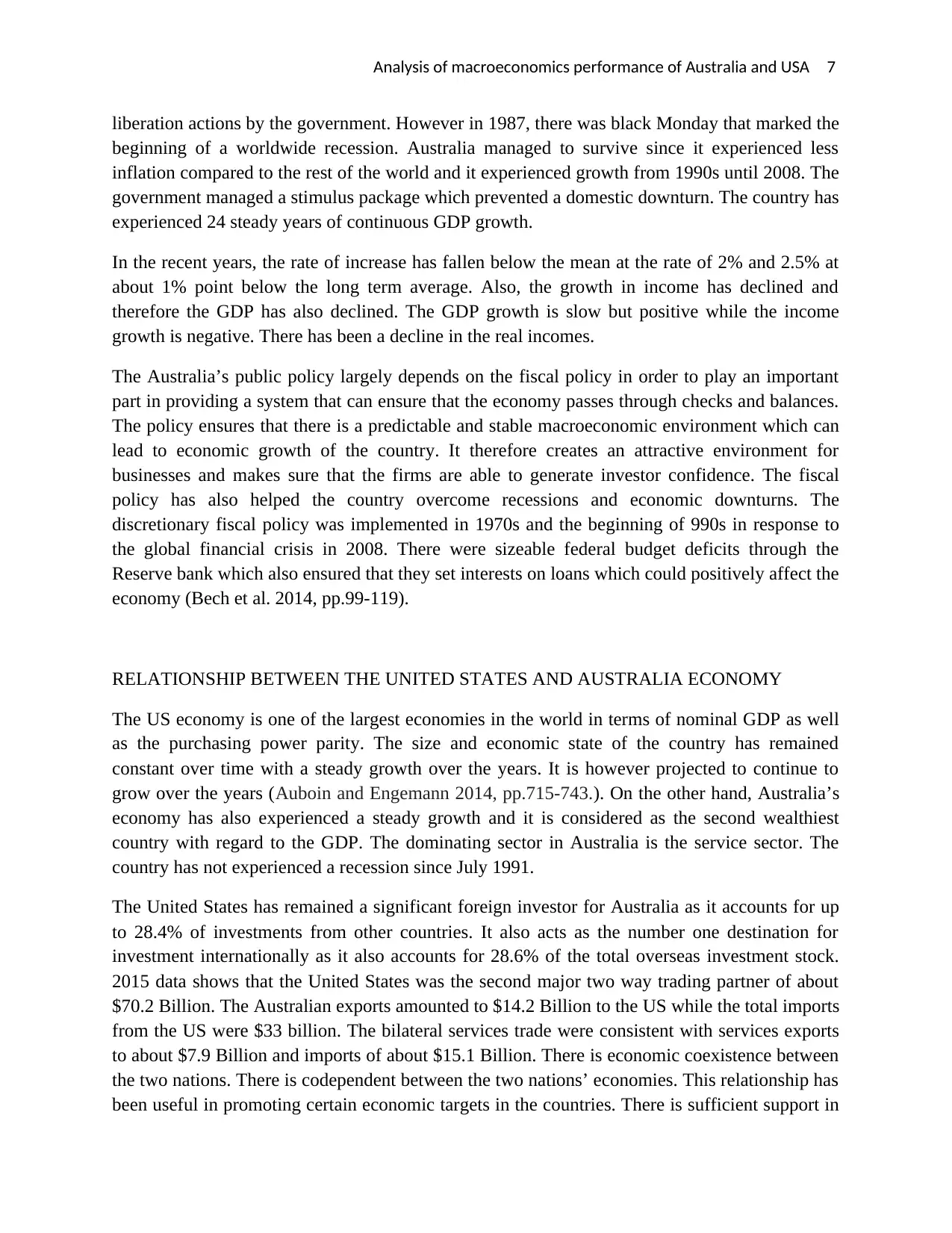
Analysis of macroeconomics performance of Australia and USA 7
liberation actions by the government. However in 1987, there was black Monday that marked the
beginning of a worldwide recession. Australia managed to survive since it experienced less
inflation compared to the rest of the world and it experienced growth from 1990s until 2008. The
government managed a stimulus package which prevented a domestic downturn. The country has
experienced 24 steady years of continuous GDP growth.
In the recent years, the rate of increase has fallen below the mean at the rate of 2% and 2.5% at
about 1% point below the long term average. Also, the growth in income has declined and
therefore the GDP has also declined. The GDP growth is slow but positive while the income
growth is negative. There has been a decline in the real incomes.
The Australia’s public policy largely depends on the fiscal policy in order to play an important
part in providing a system that can ensure that the economy passes through checks and balances.
The policy ensures that there is a predictable and stable macroeconomic environment which can
lead to economic growth of the country. It therefore creates an attractive environment for
businesses and makes sure that the firms are able to generate investor confidence. The fiscal
policy has also helped the country overcome recessions and economic downturns. The
discretionary fiscal policy was implemented in 1970s and the beginning of 990s in response to
the global financial crisis in 2008. There were sizeable federal budget deficits through the
Reserve bank which also ensured that they set interests on loans which could positively affect the
economy (Bech et al. 2014, pp.99-119).
RELATIONSHIP BETWEEN THE UNITED STATES AND AUSTRALIA ECONOMY
The US economy is one of the largest economies in the world in terms of nominal GDP as well
as the purchasing power parity. The size and economic state of the country has remained
constant over time with a steady growth over the years. It is however projected to continue to
grow over the years (Auboin and Engemann 2014, pp.715-743.). On the other hand, Australia’s
economy has also experienced a steady growth and it is considered as the second wealthiest
country with regard to the GDP. The dominating sector in Australia is the service sector. The
country has not experienced a recession since July 1991.
The United States has remained a significant foreign investor for Australia as it accounts for up
to 28.4% of investments from other countries. It also acts as the number one destination for
investment internationally as it also accounts for 28.6% of the total overseas investment stock.
2015 data shows that the United States was the second major two way trading partner of about
$70.2 Billion. The Australian exports amounted to $14.2 Billion to the US while the total imports
from the US were $33 billion. The bilateral services trade were consistent with services exports
to about $7.9 Billion and imports of about $15.1 Billion. There is economic coexistence between
the two nations. There is codependent between the two nations’ economies. This relationship has
been useful in promoting certain economic targets in the countries. There is sufficient support in
liberation actions by the government. However in 1987, there was black Monday that marked the
beginning of a worldwide recession. Australia managed to survive since it experienced less
inflation compared to the rest of the world and it experienced growth from 1990s until 2008. The
government managed a stimulus package which prevented a domestic downturn. The country has
experienced 24 steady years of continuous GDP growth.
In the recent years, the rate of increase has fallen below the mean at the rate of 2% and 2.5% at
about 1% point below the long term average. Also, the growth in income has declined and
therefore the GDP has also declined. The GDP growth is slow but positive while the income
growth is negative. There has been a decline in the real incomes.
The Australia’s public policy largely depends on the fiscal policy in order to play an important
part in providing a system that can ensure that the economy passes through checks and balances.
The policy ensures that there is a predictable and stable macroeconomic environment which can
lead to economic growth of the country. It therefore creates an attractive environment for
businesses and makes sure that the firms are able to generate investor confidence. The fiscal
policy has also helped the country overcome recessions and economic downturns. The
discretionary fiscal policy was implemented in 1970s and the beginning of 990s in response to
the global financial crisis in 2008. There were sizeable federal budget deficits through the
Reserve bank which also ensured that they set interests on loans which could positively affect the
economy (Bech et al. 2014, pp.99-119).
RELATIONSHIP BETWEEN THE UNITED STATES AND AUSTRALIA ECONOMY
The US economy is one of the largest economies in the world in terms of nominal GDP as well
as the purchasing power parity. The size and economic state of the country has remained
constant over time with a steady growth over the years. It is however projected to continue to
grow over the years (Auboin and Engemann 2014, pp.715-743.). On the other hand, Australia’s
economy has also experienced a steady growth and it is considered as the second wealthiest
country with regard to the GDP. The dominating sector in Australia is the service sector. The
country has not experienced a recession since July 1991.
The United States has remained a significant foreign investor for Australia as it accounts for up
to 28.4% of investments from other countries. It also acts as the number one destination for
investment internationally as it also accounts for 28.6% of the total overseas investment stock.
2015 data shows that the United States was the second major two way trading partner of about
$70.2 Billion. The Australian exports amounted to $14.2 Billion to the US while the total imports
from the US were $33 billion. The bilateral services trade were consistent with services exports
to about $7.9 Billion and imports of about $15.1 Billion. There is economic coexistence between
the two nations. There is codependent between the two nations’ economies. This relationship has
been useful in promoting certain economic targets in the countries. There is sufficient support in
Paraphrase This Document
Need a fresh take? Get an instant paraphrase of this document with our AI Paraphraser
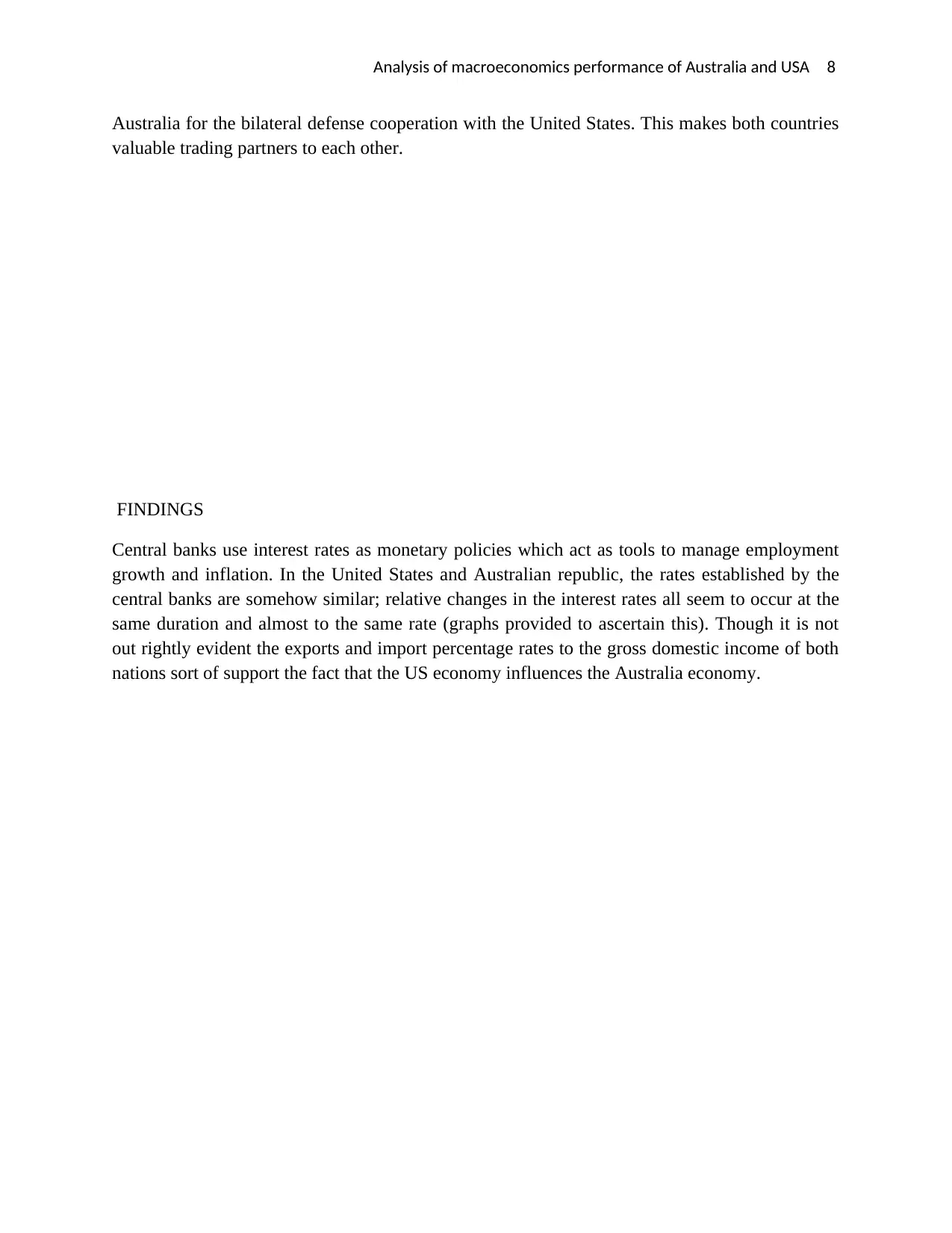
Analysis of macroeconomics performance of Australia and USA 8
Australia for the bilateral defense cooperation with the United States. This makes both countries
valuable trading partners to each other.
FINDINGS
Central banks use interest rates as monetary policies which act as tools to manage employment
growth and inflation. In the United States and Australian republic, the rates established by the
central banks are somehow similar; relative changes in the interest rates all seem to occur at the
same duration and almost to the same rate (graphs provided to ascertain this). Though it is not
out rightly evident the exports and import percentage rates to the gross domestic income of both
nations sort of support the fact that the US economy influences the Australia economy.
Australia for the bilateral defense cooperation with the United States. This makes both countries
valuable trading partners to each other.
FINDINGS
Central banks use interest rates as monetary policies which act as tools to manage employment
growth and inflation. In the United States and Australian republic, the rates established by the
central banks are somehow similar; relative changes in the interest rates all seem to occur at the
same duration and almost to the same rate (graphs provided to ascertain this). Though it is not
out rightly evident the exports and import percentage rates to the gross domestic income of both
nations sort of support the fact that the US economy influences the Australia economy.
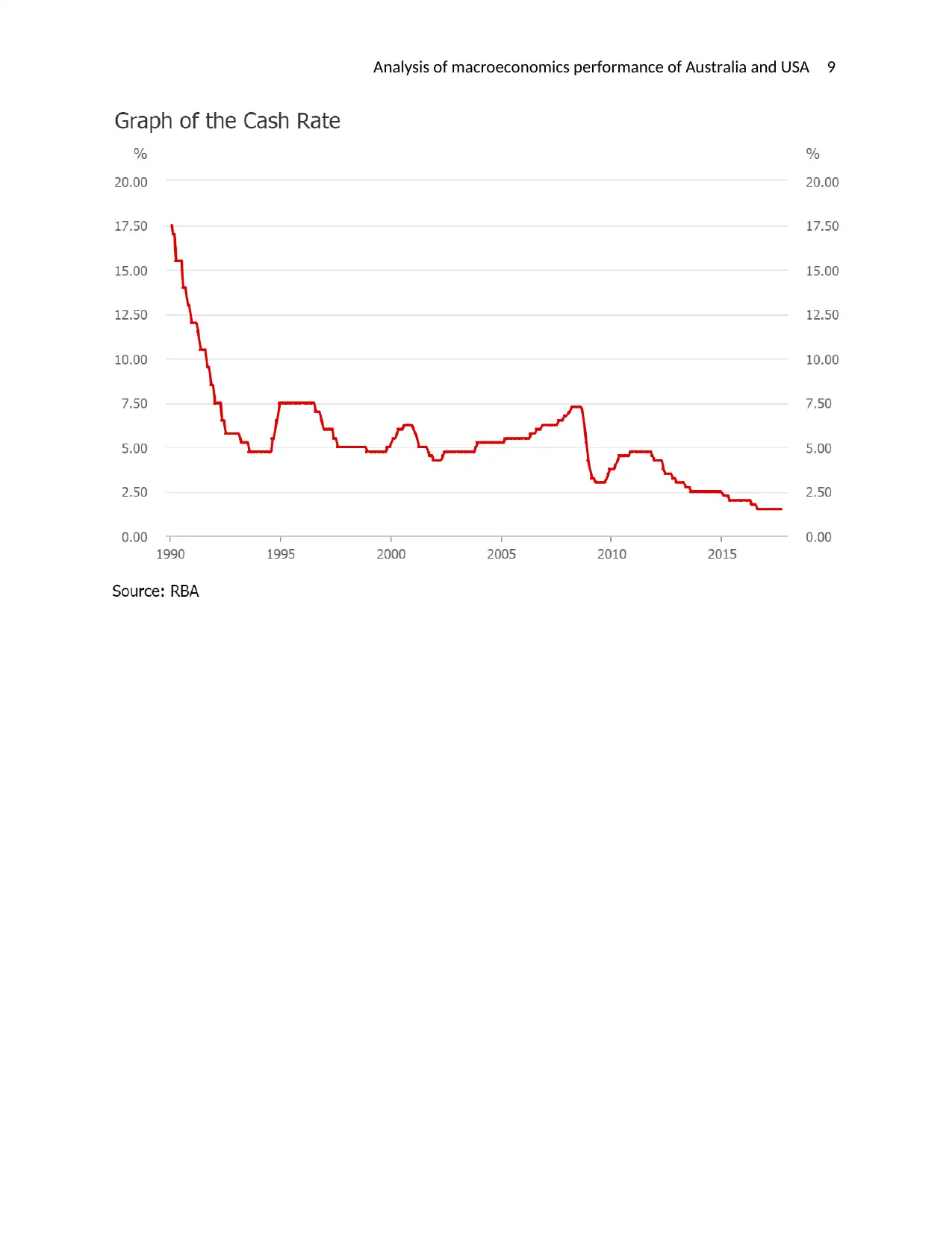
Analysis of macroeconomics performance of Australia and USA 9
⊘ This is a preview!⊘
Do you want full access?
Subscribe today to unlock all pages.

Trusted by 1+ million students worldwide
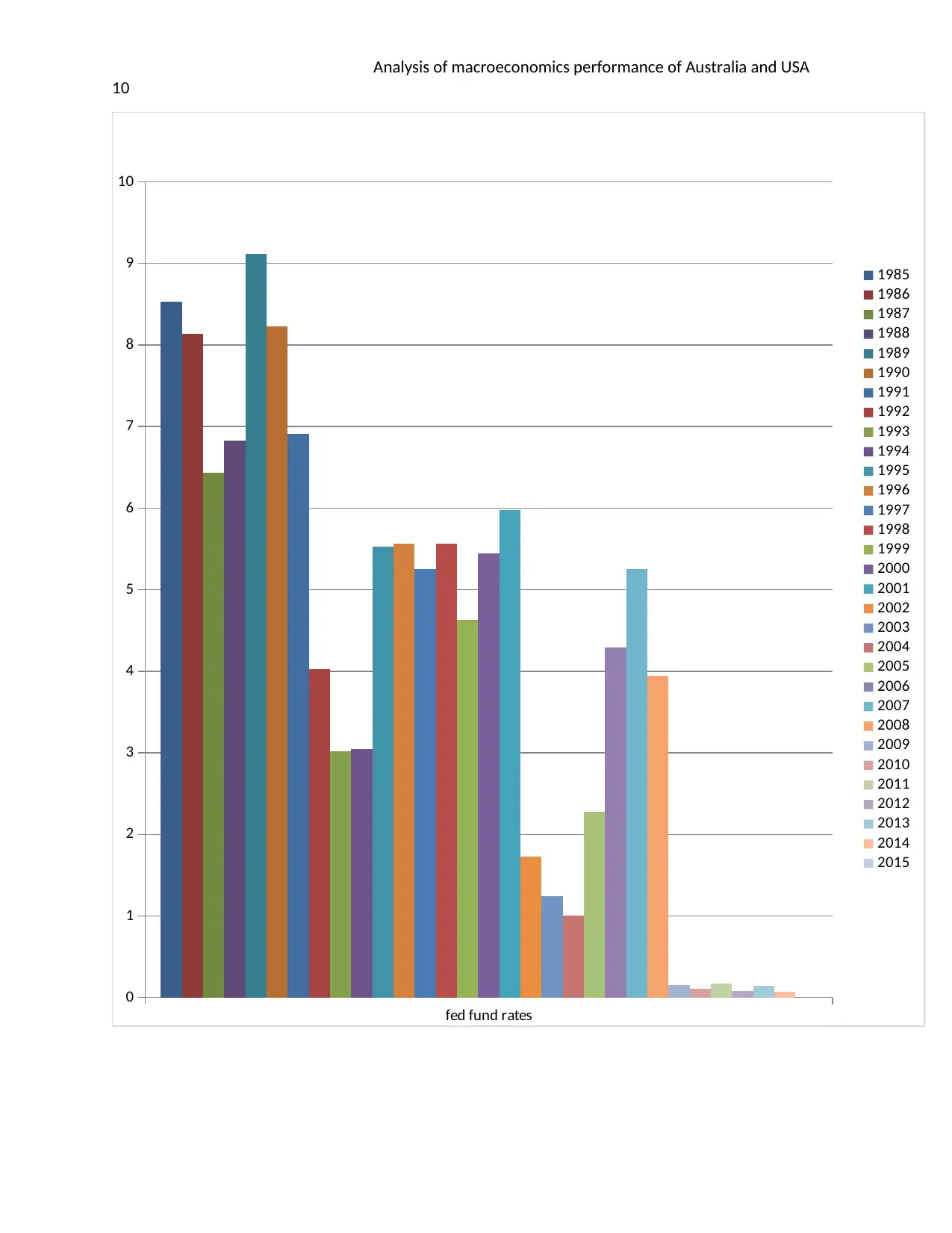
Analysis of macroeconomics performance of Australia and USA
10
fed fund rates
0
1
2
3
4
5
6
7
8
9
10
1985
1986
1987
1988
1989
1990
1991
1992
1993
1994
1995
1996
1997
1998
1999
2000
2001
2002
2003
2004
2005
2006
2007
2008
2009
2010
2011
2012
2013
2014
2015
10
fed fund rates
0
1
2
3
4
5
6
7
8
9
10
1985
1986
1987
1988
1989
1990
1991
1992
1993
1994
1995
1996
1997
1998
1999
2000
2001
2002
2003
2004
2005
2006
2007
2008
2009
2010
2011
2012
2013
2014
2015
Paraphrase This Document
Need a fresh take? Get an instant paraphrase of this document with our AI Paraphraser
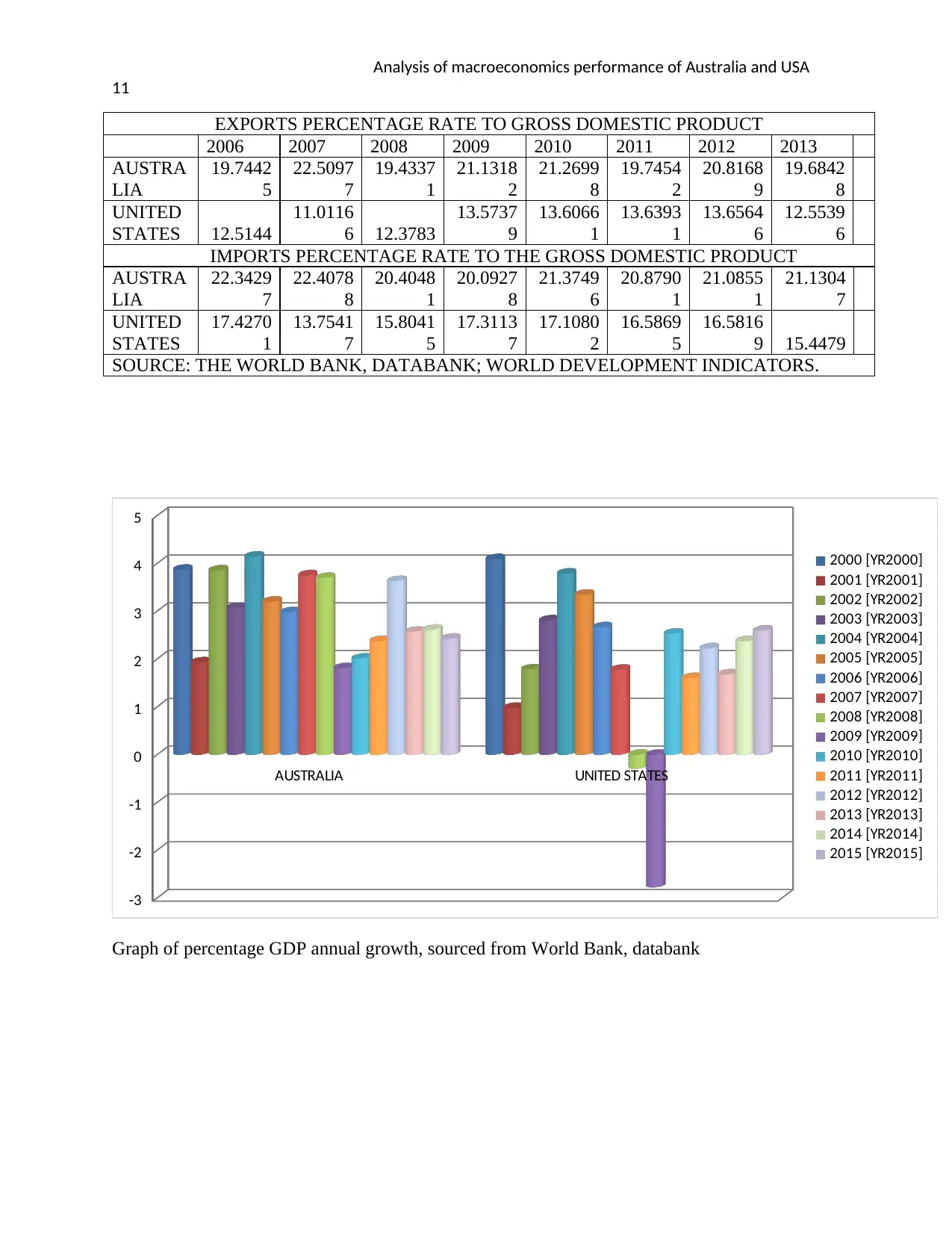
Analysis of macroeconomics performance of Australia and USA
11
EXPORTS PERCENTAGE RATE TO GROSS DOMESTIC PRODUCT
2006 2007 2008 2009 2010 2011 2012 2013
AUSTRA
LIA
19.7442
5
22.5097
7
19.4337
1
21.1318
2
21.2699
8
19.7454
2
20.8168
9
19.6842
8
UNITED
STATES 12.5144
11.0116
6 12.3783
13.5737
9
13.6066
1
13.6393
1
13.6564
6
12.5539
6
IMPORTS PERCENTAGE RATE TO THE GROSS DOMESTIC PRODUCT
AUSTRA
LIA
22.3429
7
22.4078
8
20.4048
1
20.0927
8
21.3749
6
20.8790
1
21.0855
1
21.1304
7
UNITED
STATES
17.4270
1
13.7541
7
15.8041
5
17.3113
7
17.1080
2
16.5869
5
16.5816
9 15.4479
SOURCE: THE WORLD BANK, DATABANK; WORLD DEVELOPMENT INDICATORS.
AUSTRALIA UNITED STATES
-3
-2
-1
0
1
2
3
4
5
2000 [YR2000]
2001 [YR2001]
2002 [YR2002]
2003 [YR2003]
2004 [YR2004]
2005 [YR2005]
2006 [YR2006]
2007 [YR2007]
2008 [YR2008]
2009 [YR2009]
2010 [YR2010]
2011 [YR2011]
2012 [YR2012]
2013 [YR2013]
2014 [YR2014]
2015 [YR2015]
Graph of percentage GDP annual growth, sourced from World Bank, databank
11
EXPORTS PERCENTAGE RATE TO GROSS DOMESTIC PRODUCT
2006 2007 2008 2009 2010 2011 2012 2013
AUSTRA
LIA
19.7442
5
22.5097
7
19.4337
1
21.1318
2
21.2699
8
19.7454
2
20.8168
9
19.6842
8
UNITED
STATES 12.5144
11.0116
6 12.3783
13.5737
9
13.6066
1
13.6393
1
13.6564
6
12.5539
6
IMPORTS PERCENTAGE RATE TO THE GROSS DOMESTIC PRODUCT
AUSTRA
LIA
22.3429
7
22.4078
8
20.4048
1
20.0927
8
21.3749
6
20.8790
1
21.0855
1
21.1304
7
UNITED
STATES
17.4270
1
13.7541
7
15.8041
5
17.3113
7
17.1080
2
16.5869
5
16.5816
9 15.4479
SOURCE: THE WORLD BANK, DATABANK; WORLD DEVELOPMENT INDICATORS.
AUSTRALIA UNITED STATES
-3
-2
-1
0
1
2
3
4
5
2000 [YR2000]
2001 [YR2001]
2002 [YR2002]
2003 [YR2003]
2004 [YR2004]
2005 [YR2005]
2006 [YR2006]
2007 [YR2007]
2008 [YR2008]
2009 [YR2009]
2010 [YR2010]
2011 [YR2011]
2012 [YR2012]
2013 [YR2013]
2014 [YR2014]
2015 [YR2015]
Graph of percentage GDP annual growth, sourced from World Bank, databank
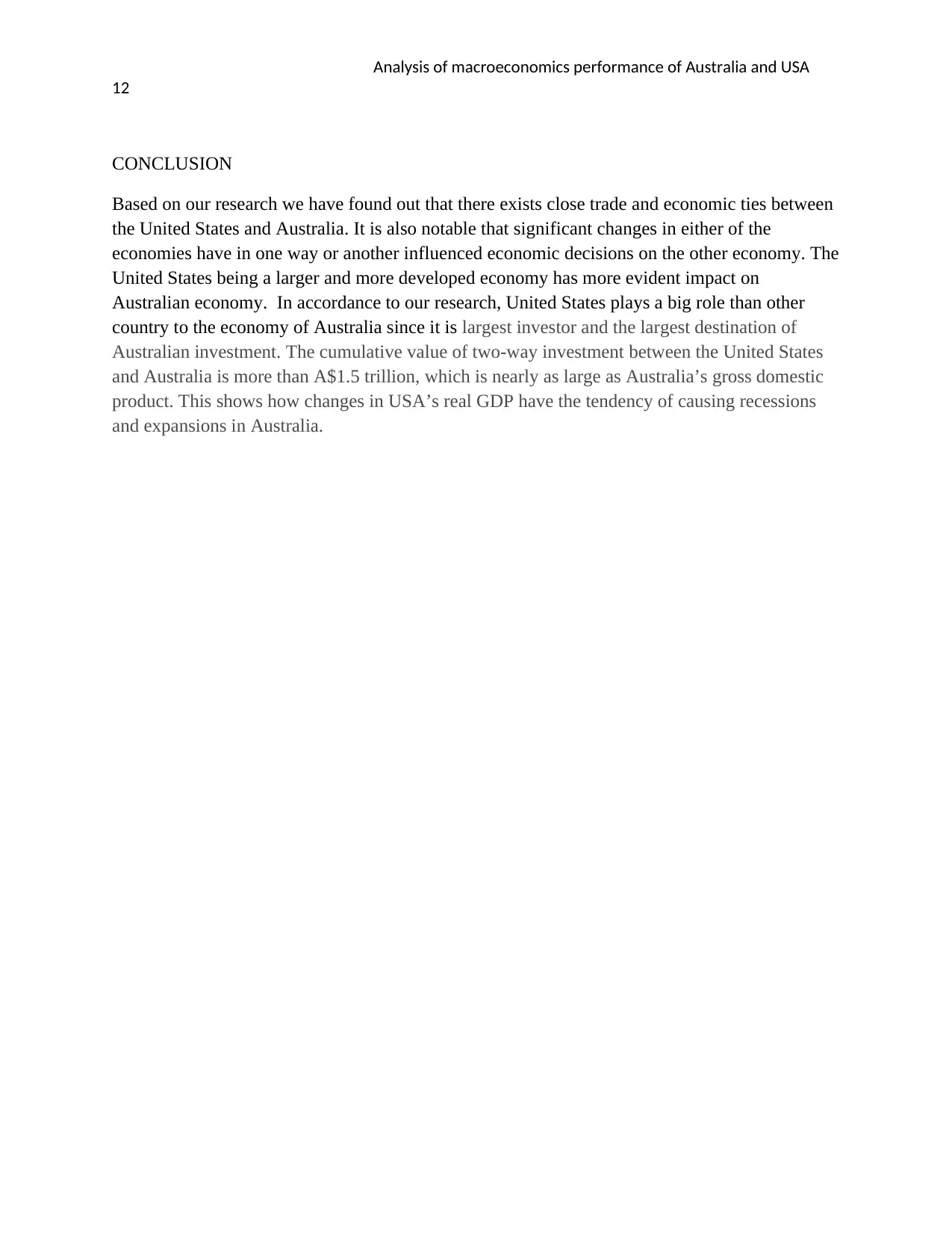
Analysis of macroeconomics performance of Australia and USA
12
CONCLUSION
Based on our research we have found out that there exists close trade and economic ties between
the United States and Australia. It is also notable that significant changes in either of the
economies have in one way or another influenced economic decisions on the other economy. The
United States being a larger and more developed economy has more evident impact on
Australian economy. In accordance to our research, United States plays a big role than other
country to the economy of Australia since it is largest investor and the largest destination of
Australian investment. The cumulative value of two-way investment between the United States
and Australia is more than A$1.5 trillion, which is nearly as large as Australia’s gross domestic
product. This shows how changes in USA’s real GDP have the tendency of causing recessions
and expansions in Australia.
12
CONCLUSION
Based on our research we have found out that there exists close trade and economic ties between
the United States and Australia. It is also notable that significant changes in either of the
economies have in one way or another influenced economic decisions on the other economy. The
United States being a larger and more developed economy has more evident impact on
Australian economy. In accordance to our research, United States plays a big role than other
country to the economy of Australia since it is largest investor and the largest destination of
Australian investment. The cumulative value of two-way investment between the United States
and Australia is more than A$1.5 trillion, which is nearly as large as Australia’s gross domestic
product. This shows how changes in USA’s real GDP have the tendency of causing recessions
and expansions in Australia.
⊘ This is a preview!⊘
Do you want full access?
Subscribe today to unlock all pages.

Trusted by 1+ million students worldwide
1 out of 13
Related Documents
Your All-in-One AI-Powered Toolkit for Academic Success.
+13062052269
info@desklib.com
Available 24*7 on WhatsApp / Email
![[object Object]](/_next/static/media/star-bottom.7253800d.svg)
Unlock your academic potential
Copyright © 2020–2025 A2Z Services. All Rights Reserved. Developed and managed by ZUCOL.





